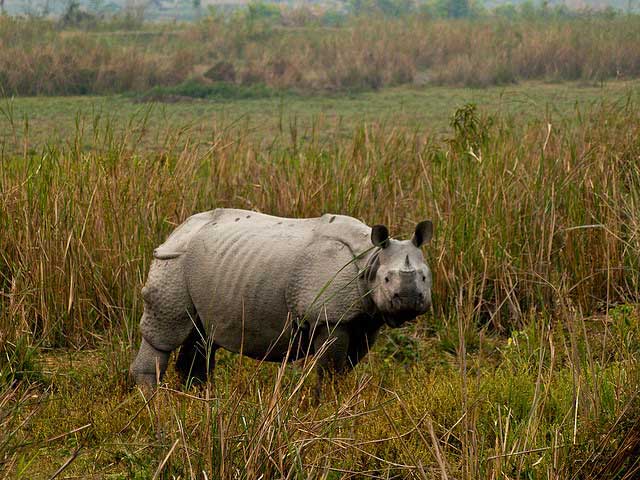Known to be one of the last bastions of the Indian One-Horned Rhinoceros, Kaziranga National Park is located in the Indian state of Assam. The protected area was established in 1904 following the efforts of Lady Curzon, the wife of Lord Curzon, the then Viceroy of India under the British Raj. Today’ the park is spread around an area of 430 square kilometers and is also known as a major ‘Tiger Reserve’ in India. When the Lady failed to see a single Rhinoceros upon her visit, she persuaded the Viceroy to facilitate the protection of the forests and the wildlife. The park has also been declared a UNESCO world heritage site.
Kaziranga National Park is located by the banks of the mighty Brahmaputra River and is shared by two districts in Assam. The terrain in the park comprises mainly of sandbanks, riverine lakes, Semi-evergreen forests, moist broad-leaf forests and grasslands. The park is spread in a massive area which makes it one of the largest protected forests in the Sub-Himalayan belt.
Climatic Conditions
Being located in one of the highest rainfall prone areas of the Middle Brahmaputra Valley, Kaziranga National Park experiences a humid monsoon season between July and September when most of the areas near the shores are submerged. The summer months fall between February and May when the temperatures can go upto 37 degrees. The winter months fall between November and February which enjoys a favorable and pleasant climate with temperatures never exceeding beyond 25 degrees Celsius.
Best Time to Visit
The park is flooded and inaccessible during the monsoon months between July and September and the summer months see little to no fauna activity and the park is also closed for public. The best time to visit Kaziranga National Park is between September till December when the climate is the most favorable and pleasant following the monsoons. The winters at Kaziranga National Park is enchanting with the best views of the fauna and flora that the park houses.
Wildlife at Kaziranga National Park
As the national park is one of the largest protected areas in India, it houses several rare and endangered species of animals, birds and reptiles. Approximately 35 mammalian species, 479 species of birds and 42 species of reptiles can be found in the park.
Animals – The Great One-Horned Indian Rhinoceros, Wild Asian Water Buffalo, Indian Elephant, Royal Bengal Tiger, Indian Wild Boar, Eastern Mole, Indian Pangolin, Indian Gaur, Swamp Deer, Sambar, Barking Deer, Hoolock, Hog Deer, Capped Langur or Leaf Monkey, Rhesus Macaque, Assamese Macaque, Indian leopard, Sloth Bear, Indian Porcupine, Fishing Cat, Jungle Cat, Large Indian Civet, Small Indian Civet, Indian Gray Mongoose, Small Indian Mongoose, Bengal Fox, Golden Jackal, Common Otter, Chinese Ferret Badger, Hog Badger, Ganges and Indus River Dolphin, Orange-bellied Himalayan Squirrel, Asiatic Black Bear, Bat, Black Langur and Indian Gazelle etc.
Birds – Eastern Imperial Eagle, Bengal Florican, Greater Spotted Eagle, White-tailed Fishing Eagle, Pallas’s Fish Eagle, Grey-headed Fish Eagle, Bristled Grassbird, Baya Weaver, the Lesser Kestrel, Swamp Francolin, Slender-billed Vulture, Slender-billed Vulture, the Indian White-rumped Vulture Hodgson’s Bushchat, Eastern Imperial Eagle, Greater Spotted Eagle, Wreathed Hornbill, Jerdon’s Babbler, Marsh Babbler White-tailed Fishing Eagle, Pallas’s Fish Eagle, Black-breasted Parrotbill, Griffon Vulture, Himalayan Griffon and Rufous-vented Prinia etc.
Reptiles – Gharial, Turtles, Water Monitors, Bengal Monitors, Assam Garden Lizards, Common Indian Skink, Black Krait, Bengal Cobra, King Cobra, Reticulated Python, Russell’s Viper, Rat Snake, Long nosed-vine snake, Kukri Snake etc.
Distance from Nearby and Major Cities
1. Guwahati to Kaziranga National Park– 194 kilometers
2. Johrat to Kaziranga National Park– 112 kilometers
3. Tezpur to Kaziranga National Park– 51 kilometers
4. Shillong to Kaziranga National Park– 254 kilometers
5. Kolkata to Kaziranga National Park– 1127 kilometers
6. Lucknow to Kaziranga National Park– 1460 kilometers
7. Delhi to Kaziranga National Park– 2095 kilometers
8. Jaipur to Kaziranga National Park– 2119 kilometers
9. Hyderabad to Kaziranga National Park– 2065 kilometers
10. Bangalore to Kaziranga National Park– 2982 kilometers
11. Chennai to Kaziranga National Park– 2777 kilometers
12. Mumbai to Kaziranga National Park– 2766 kilometers
13. Chandigarh to Kaziranga National Park– 2138 kilometers
14. Allahabad to Kaziranga National Park– 1400 kilometers
15. Ahmedabad to Kaziranga National Park– 2678 kilometers
Nearest Airport – Johrat and Tezpur are two airports that are approximately 112 and 51 kilometers away from Kaziranga National Park. These airports are well connected with the other international airports in India.
Nearest Railway Station – The nearest railway station is approximately 80 kilometers away from the national park in the town of Furkating. Trains to Furkating are available via Guwahati which is well connected with the rest of India by rail.
Road Accessibility – Kaziranga National Park is well connected with the rest of the state of Assam by roads and can be easily reached by car, bus or taxi.
Accommodation Facilities – There are several governments owned and private owned lodging facilities at the Kohora Bus stop and thanks to the close proximity of the ‘Kaziranga Development and Jeep Safari Association’, is the best place to book your jeep or elephant safaris.
Entry Fee – As with most protected forests, the fee for Indian visitors and foreign visitors differ by a great degree, with the entrance fee for Indians being as low as Rs. 50 and Rs. 500 for the foreign tourists. The visitors can either hire a jeep or an elephant for the best views of the vivid wildlife the park enshrines. Extra fee for camera and photography permits might be applicable.
Useful Contacts for Booking and Accommodation
Director of Tourism, Guwahati – 0361-2547102, 2542748
Wild Grass Resort – 0091 3776 262085



Need a vehicle to visit the park for 4 person next week.